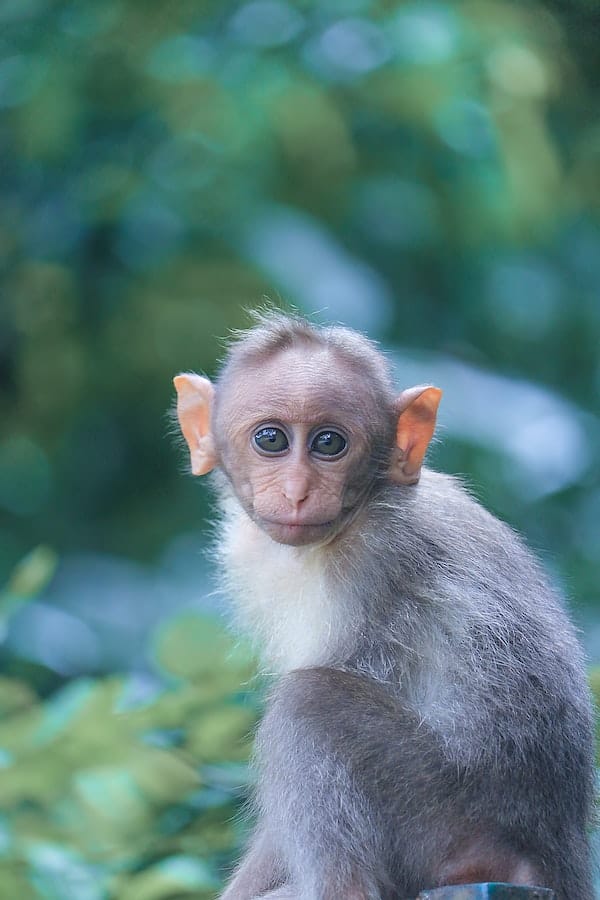
Monkeys are fascinating creatures with many interesting characteristics and behaviors.
Whether you’re interested in their physical features, social behaviors, or diet and habitat, there is always something new to learn about these fascinating animals.
Here are just a few interesting monkey facts to get you started on your journey of discovery:
Fact #1: There are over 260 species of monkeys.
Monkeys are diverse animals, with over 260 different species to choose from.
Some of the most well-known and commonly encountered species include the capuchin monkey, the squirrel monkey, and the macaque.
Each of these species has its own unique physical features, social behaviors, and dietary preferences that set it apart from other types of monkeys.
Fact #2: Monkeys range in size.
Monkeys come in a wide variety of different sizes and shapes, ranging from tiny marmosets to giant baboons.
Some of the smallest monkeys are just a few inches in length, while some of the largest can grow to be several feet tall.
In general, monkeys tend to have long tails, strong limbs, dexterous hands and feet, and large, expressive eyes.
Fact #3: Monkeys live in a variety of different habitats.

Monkeys are incredibly adaptable animals and can be found living in a wide variety of different habitats around the world.
Some types of monkeys prefer to live in dense forests or jungles, while others thrive in more open, arid environments such as savannas or deserts.
In general, monkeys need access to plenty of food and water, as well as trees or other structures for climbing and sleeping.
Fact #4: Monkeys live in tropical and subtropical regions.
Monkeys are found in a wide variety of different tropical and subtropical regions around the world, including forests, jungles, savannas, and deserts.
This is due to their ability to adapt to a range of different habitats, as well as their need for plenty of food and water.
In order to survive in these regions, monkeys have developed unique social behaviors, physical characteristics, and dietary preferences that help them thrive in these environments.
Fact #5: Most monkeys are arboreal, meaning they live in trees.
Many types of monkeys are arboreal, meaning that they spend most of their time living in trees.
This allows them to take advantage of the abundant food sources, shelter, and protection from predators that can be found in the treetops.
In order to move efficiently between different tree branches, many arboreal monkeys have developed strong, dexterous limbs, as well as long tails that help them to balance and maneuver in the trees.
Additionally, arboreal monkeys have large, expressive eyes that allow them to see easily in dimly lit forests and jungles.
Fact #6: Some monkey species are terrestrial, meaning they live on the ground.
Many types of monkeys are terrestrial, meaning that they spend most of their time living on the ground.
This may be due to a variety of different factors, including their need for access to food sources that are not easily available in trees or other arboreal habitats.
Additionally, terrestrial monkeys may take advantage of their large size and strength to defend themselves against predators in open environments.
Fact #7: Monkeys are omnivorous, meaning they eat both plants and animals.

Monkeys are omnivorous animals, meaning that they eat both plants and animals in order to meet their nutritional needs.
In general, monkeys have evolved unique dietary preferences and behaviors that help them to find and consume the foods they need in their natural environments.
For example, many arboreal monkeys are excellent climbers and use their long tails to hang from tree branches while foraging for fruit, leaves, and other plant-based foods.
- Related post: How to name your pet monkey
- Related post: Planet of Apes inspired monkey names
Fact #8: The majority of monkeys eat fruits, leaves, flowers, and nuts, but some species also eat insects, eggs, and small mammals.
The majority of monkeys are omnivorous animals, meaning that they eat both plant-based and animal-based foods in order to meet their nutritional needs.
In general, monkeys have evolved unique dietary preferences and behaviors that allow them to find and consume the fruits, leaves, flowers, nuts, insects, eggs, and small mammals that they need in their natural environments.
Fact #9. Monkeys are social animals and live in groups called troops.
Monkeys are social animals, living in groups called troops. These groups typically consist of around 20 to 50 individuals, depending on the species of monkey and the environment in which they live.
Within these troops, monkeys form hierarchies based on age, sex, and other factors, with dominant individuals occupying the highest positions.
Fact #10: Troops can range in size from just a few individuals to over 500 individuals.
Troops of monkeys can range in size from just a few individuals to over 500 individuals, depending on the species and environment.
This is due to a variety of different factors, including the availability of food sources, predators, and other environmental conditions.
In general, larger groups provide monkeys with greater protection against predators and allow them to share resources like food and shelter more easily.
However, larger groups also require more energy to maintain, so there is a tradeoff between group size and other factors like resource availability.
Fact #11: Monkeys use a variety of vocalizations to communicate with each other, including screams, grunts, barks, and hoots.
Monkeys use a variety of vocalizations to communicate with each other, including screams, grunts, barks, and hoots.
These calls are used for a number of purposes, including warning others about potential predators, attracting mates, and maintaining social cohesion within the troop.
Fact #12: Some monkey species are capable of using basic sign language to communicate with humans.

Some monkey species are capable of using basic sign language to communicate with humans.
This unique ability has been observed in a number of different species, including the orangutan, bonobo, and capuchin monkey.
By studying these animals closely, scientists have been able to learn more about how they process language and develop communication skills.
In addition to using basic sign language, some monkeys are also able to understand human speech and can even imitate certain sounds.
This makes them valuable research subjects for scientists who are trying to better understand how humans communicate.
Fact #13: Monkeys are intelligent animals and have been shown to use tools and solve problems
Monkeys are highly intelligent animals, capable of using tools and solving problems.
This ability has been observed in many different species, including the capuchin monkey, orangutan, and bonobo.
Scientists believe that this intelligence is partially driven by the need for monkeys to adapt to their complex and ever-changing environments.
Overall, monkeys are fascinating animals with a variety of unique behaviors and adaptations that make them well-suited to their environments.
Whether they are living in small troops or large groups, these intelligent animals demonstrate an impressive ability to communicate, solve problems, and use tools.
As we continue to learn more about monkeys and their behavior, we can gain valuable insights into the evolution of intelligence and behavior in humans as well.


GIPHY App Key not set. Please check settings